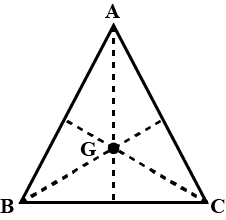Question
Question: Three equal masses of \[\;m\] kg each are fixed at the vertices of an equilateral triangle \[ABC\]. ...
Three equal masses of m kg each are fixed at the vertices of an equilateral triangle ABC.
a. What is the force acting on a mass 2m placed at the centroid G of the triangle?
b. What is the force if the mass at vertex A is doubled? Take AG=BG=CG=1m.

Solution
Gravitational forces produced by the various regions of the shell have components alongside the line joining the point mass to the center and along a direction perpendicular to this line. The components perpendicular to this line cancels out when totaling over all regions of the shell leaving behind only a resulting force along the line connecting the point to the center.
Complete step by step solution:
Let us take the masses m1,m2, Gravitational constant G and the distance between them asl, where we can get the gravitational force by FG=G12m1×m2
A. For the first case, From the figure, we can say that the gravitational force F on mass 2m at G due to mass at Ais
F1=G12m×2m=2Gm2along GA
The gravitational force F on mass 2m at G because of mass atB is
F2=G12m×2m=2Gm2along BG
The gravitational force Fon mass 2m at because of mass at C is F3=G12m×2m=2Gm2along GC
Then draw DEa parallel to BCpassing through the pointG. Then∠EGC=30o=∠DGB.

Resolving F2 and F3 into two rectangular components, we can get
F2cos30oalong GDand F2cos30oalong GH
F3cos30oalong GEand F2cos30oalong GH
Here,F2cos30oand F3cos30oare the same in magnitude and acting in reverse directions, and cancel out each other. The resulting force on mass 2m at G is
FR=F1−(F2sin30o+F3sin30o)
FR=2Gm2−(2Gm2×21+2Gm2×21)
FR=0 this is the required answer
B. For the second case, When mass at A is 2m, then gravitational force on mass 2m atG due to mass 2m at A is
F1=G122m×2m=4Gm2along GA
The resulting force on mass 2m at G due to masses atA,B and Cis
F1=(F2sin30o+F3sin30o)
=4Gm2−(2Gm2×21+2Gm2×21)
=2Gm2along GA this is the required answer.
Note:
Every point mass in the extended object will apply a force on the known point mass and these forces will not all be in a similar direction. We have to add up these forces along with their vectors for all the point masses in the extended object to obtain the total force. The force of attraction between a hollow spherical shell of uniform density and a point mass located outside is just as if the total mass of the shell is concentrated at the center of the shell.
